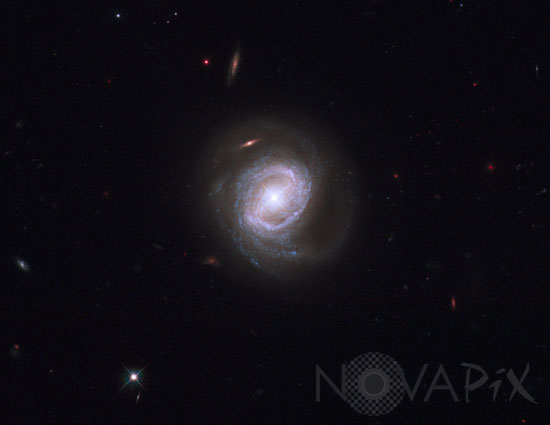Photo Agency - Astronomy - Space - Nature

Galaxy Markarian 817
author: Nasa/ESA/Novapix
reference: a-gax95-00330
Image Size 300 DPI: 23 * 18 cm
Rings of brilliant blue stars encircle the bright, active core of this spiral galaxy, whose monster black hole is blasting material into space at over 14 million kilometres per hour. Viewed nearly face-on, the galaxy, called Markarian 817, shows intense star-forming regions and dark bands of interstellar dust along its spiral arms.
Observations by the new Cosmic Origins Spectrograph (COS) aboard the NASA/ESA Hubble Space Telescope captured the powerful outflow of material from this galaxy.
The COS spectrum of Markarian 817 highlights the outflow's dynamic nature. A gas cloud containing hydrogen that was detected in Hubble data taken in 1997 does not appear in the COS observation because the cloud has apparently been driven out by an outflow of material from the galaxy.
This discharge is being powered by a huge disc of matter encircling the supermassive black hole, which is 40 million times more massive than our Sun. The disc is driving the material out of the galaxy through powerful winds, produced by streams of charged particles. Some of the outflow rains back onto the galaxy. The rest settles into the intergalactic gas.
Markarian 817 is 430 million light-years away in the northern constellation of Draco. The Hubble image was taken with the Wide Field Camera 3 on 2 August 2009. The composite image was made by using filters that isolate light from the blue, green and infrared portions of the spectrum, as well as emission from glowing hydrogen.
Keywords for this photo:
2009 - ASTRONOMY - BLACK HOLE - DRACO - GALAXY - HST - HUBBLE SPACE TELESCOPE - MARKARIAN 817 - SPIRAL GALAXY - STAR - SUPERMASSIVE BLACK HOLE -
Contact : Stéphane Aubin +33-(0)9-51-26-53-76
© Novapix - All rights reserved


